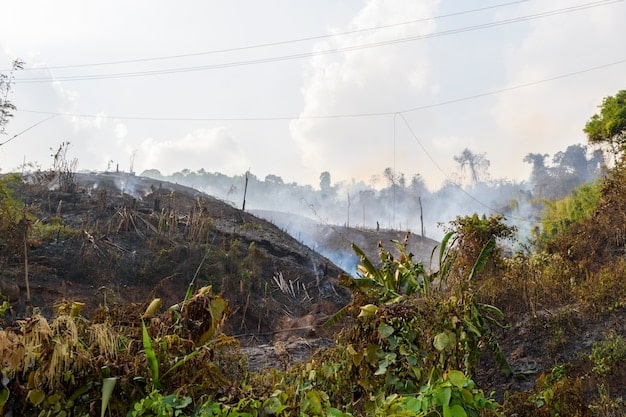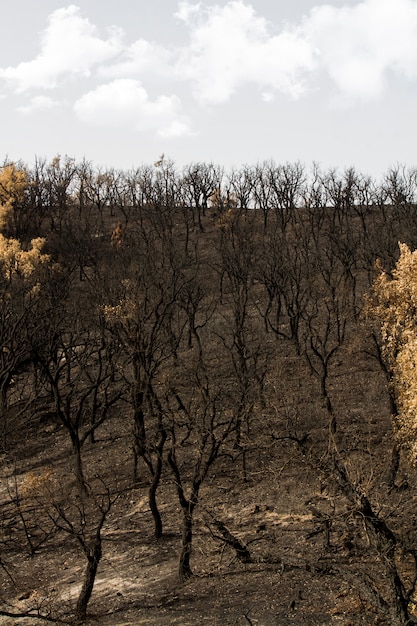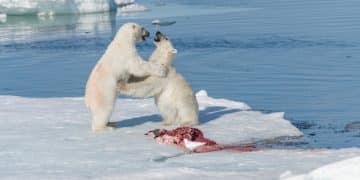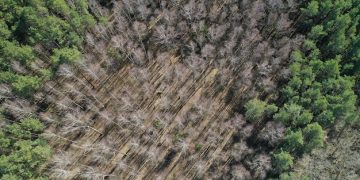Deforestation & Zoonotic Diseases in the US: Assessing the Risk

Deforestation in the United States increases the risk of zoonotic diseases by disrupting ecosystems, forcing wildlife into closer contact with humans, and potentially accelerating the transmission of pathogens.
The relentless march of deforestation across the globe is not just an environmental tragedy; it’s a potential public health crisis ticking away. In the US, the clearing of forests is increasingly linked to the emergence and spread of deforestation and the spread of zoonotic diseases in the US: what’s the risk?
Understanding the Link Between Deforestation and Zoonotic Diseases
Deforestation, the clearing of forests for other land uses, isn’t just an environmental issue. It’s a growing concern for public health, especially regarding the spread of diseases from animals to humans, known as zoonotic diseases. This section explores the intricate connection between deforestation and the rising risk of these diseases in the United States.
How Deforestation Disrupts Ecosystems
When forests are cleared, the delicate balance of ecosystems is thrown into disarray. Wild animals lose their habitats, and previously isolated pathogens gain new opportunities to spread.
Increased Human-Wildlife Contact
Deforestation often leads to increased interaction between humans and wildlife, creating pathways for diseases to jump from animals to people.
- Habitat Loss: Animals are forced out of their natural homes and into human-populated areas in search of food.
- Fragmented Habitats: Smaller, isolated forest patches limit wildlife populations and increase stress, making them more susceptible to disease.
- Agricultural Expansion: Converting forests into farmland brings humans and livestock into close proximity with wildlife, facilitating disease transmission.
Ultimately, the disruption caused by deforestation makes the emergence and spread of zoonotic diseases more likely. Understanding this connection is crucial for developing strategies to mitigate the risks.
Zoonotic Diseases of Concern in the US
The United States faces a variety of zoonotic diseases that are influenced by deforestation. While some of these diseases are well-known, others are emerging threats that warrant careful attention. This section highlights specific zoonotic diseases that are of particular concern in the context of deforestation in the US.

Lyme Disease
Lyme disease, transmitted by ticks, is prevalent in forested areas of the US. Deforestation can alter tick habitats and increase the risk of human exposure.
West Nile Virus
This mosquito-borne virus is widespread across the US, and deforestation can create new breeding grounds for mosquitoes, leading to increased transmission.
Additionally, other diseases like hantavirus, leptospirosis, and rabies are also connected. The destruction of natural habitats forces infected animals toward human populations. Monitoring these diseases and understanding their links to deforestation is key to protecting public health.
Specific US Regions at High Risk
Certain regions in the United States are more vulnerable to the zoonotic disease risks associated with deforestation. These areas often have a combination of extensive forests, high rates of deforestation, and significant human populations. This section identifies specific US regions where the risks of zoonotic disease emergence and transmission are particularly elevated due to deforestation.
Southeastern United States
The Southeast, with its rich biodiversity and rapid deforestation, is a hotspot for zoonotic diseases. The conversion of forests into agricultural land and urban areas has brought humans and wildlife into closer contact.
Pacific Northwest
The Pacific Northwest’s dense forests are also experiencing significant deforestation. This region is at risk for diseases transmitted by rodents and ticks.
- Increased Human-Wildlife Interactions: Deforestation leads to more encounters between people and animals, raising the risk of disease transmission.
- Habitat Fragmentation: Smaller, isolated forest patches disrupt wildlife populations and increase disease susceptibility.
- Climate Change Effects: Warmer temperatures and altered rainfall patterns can further exacerbate the spread of zoonotic diseases.
Focusing on these high-risk regions is crucial for implementing targeted prevention and mitigation strategies.
The Role of Climate Change in Exacerbating the Problem
Climate change acts as a threat multiplier in the relationship between deforestation and zoonotic diseases. Altered weather patterns, rising temperatures, and increased frequency of extreme events can all exacerbate the risks. This section explores the ways in which climate change amplifies the impact of deforestation on the spread of zoonotic diseases in the United States.

Altered Weather Patterns
Changes in temperature and rainfall can affect the distribution and behavior of both disease vectors (like mosquitoes and ticks) and animal hosts. Warmer temperatures can allow vectors to expand their ranges into new areas, increasing the potential for disease transmission.
Increased Extreme Events
Droughts, floods, and wildfires, which are becoming more frequent and intense due to climate change, can further disrupt ecosystems and increase human-wildlife contact. These events can force animals to migrate in search of resources, bringing them into closer proximity with human populations.
Addressing climate change is essential for mitigating the long-term risks of zoonotic diseases linked to deforestation. Reducing greenhouse gas emissions and promoting sustainable land management practices can help to protect both human and environmental health.
Prevention and Mitigation Strategies
Effectively addressing the risks requires a multi-faceted approach that combines environmental conservation, public health measures, and community engagement. This section outlines several key strategies that can be implemented to prevent and mitigate the spread of zoonotic diseases linked to deforestation in the United States.
Sustainable Land Management
Promoting sustainable forestry practices and responsible land-use planning can help to minimize deforestation and its associated risks.
Public Health Surveillance and Response
Strengthening public health surveillance systems is crucial for early detection and rapid response to zoonotic disease outbreaks.
- Early Detection: Implementing robust surveillance programs to monitor disease activity in both animal and human populations.
- Rapid Response: Developing effective response strategies to contain outbreaks and prevent further spread.
- Community Engagement: Educating the public about zoonotic disease risks and promoting preventive behaviors.
By implementing these strategies, we can reduce the risk of zoonotic diseases and protect the health of both people and the environment.
The Economic and Social Costs of Inaction
The economic and social costs of ignoring the link between deforestation and zoonotic diseases can be substantial. From healthcare expenses to lost productivity and impacts on tourism, the consequences of inaction can ripple through communities and economies. This section examines the potential economic and social costs of failing to address the risks associated with deforestation in the United States.
Healthcare Costs
Zoonotic disease outbreaks can lead to significant increases in healthcare costs, including expenses for treatment, hospitalization, and public health interventions.
Economic Disruptions
Outbreaks can disrupt economic activities, such as agriculture, tourism, and outdoor recreation. Travel restrictions and quarantines can further exacerbate economic losses.
Investing in prevention and mitigation strategies is not only a matter of public health but also a sound economic decision. The costs of inaction far outweigh the costs of implementing effective measures to protect against zoonotic diseases.
| Key Point | Brief Description |
|---|---|
| 🌳 Deforestation | Clearing forests increases human-wildlife interactions. |
| 🦠 Zoonotic Diseases | Diseases transmitted from animals to humans rise. |
| 🌡️ Climate Change | Exacerbates the spread of diseases via altered weather. |
| 🛡️ Prevention | Sustainable land management and public health. |
Frequently Asked Questions
▼
Deforestation disrupts ecosystems, forcing animals into closer contact with humans. This increases the likelihood of pathogens jumping from wildlife to people, resulting in the emergence and spread of zoonotic diseases.
▼
The Southeastern United States and the Pacific Northwest are particularly vulnerable. Both regions have significant deforestation rates, high biodiversity, and large human populations, increasing the risk of disease transmission.
▼
Climate change exacerbates the problem by altering weather patterns and increasing extreme events. These changes disrupt ecosystems and force animals into closer proximity with humans, further increasing disease transmission risks.
▼
Strategies include promoting sustainable land management, strengthening public health surveillance, and engaging communities. These measures help to minimize deforestation and ensure early detection and rapid response to disease outbreaks.
▼
Ignoring the problem can lead to significant healthcare costs, economic disruptions, and impacts on tourism and agriculture. Investing in prevention is economically sound, as the costs of inaction far outweigh the investment in protective measures.
Conclusion
The intricate link between deforestation and the spread of zoonotic diseases in the US: what’s the risk? is a growing concern that demands immediate attention. By understanding the ecological dynamics at play and implementing robust mitigation strategies, we can protect both human and environmental health.





